Bournemouth, UK, July 11th - 16th, 1910
The first 1910 British international aviation meeting



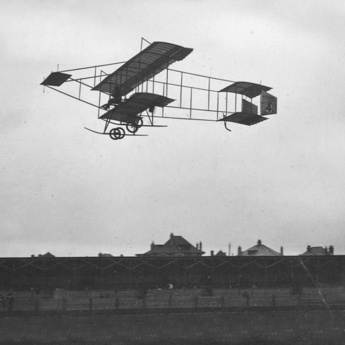



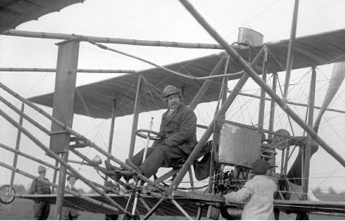


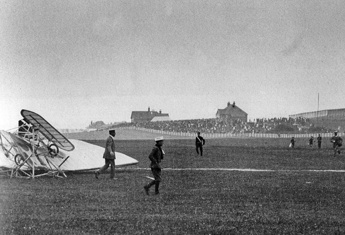

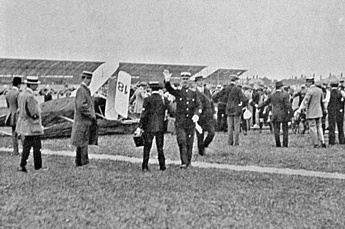



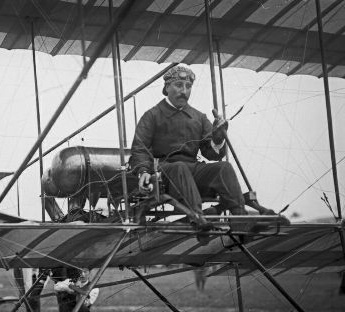
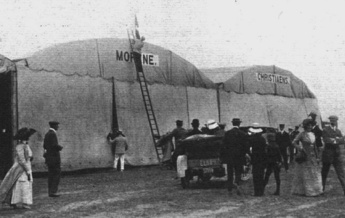
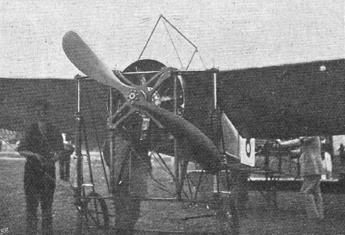
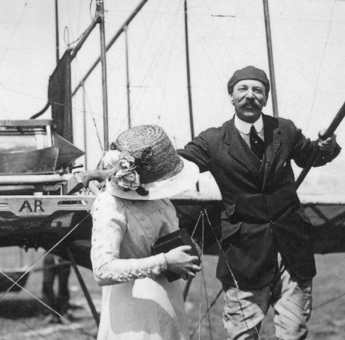
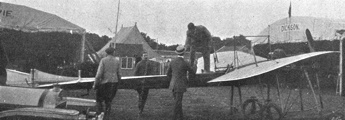
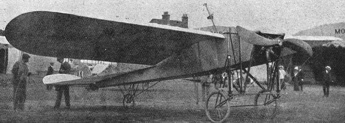


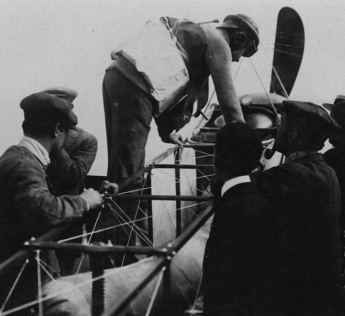
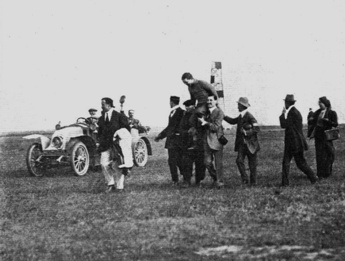







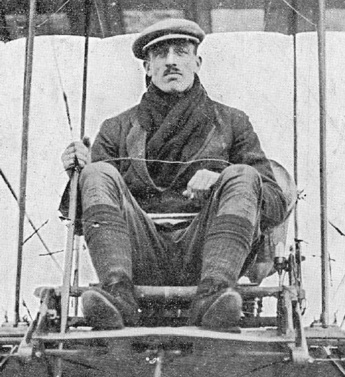

Bournemouth is a coastal resort town in Dorset (until
1974 in Hampshire), on the south coast of England. It was
founded in 1810 by Lewis Tregonwell, who built the first
house in what was then a deserted heathland, occasionally
visited by fishermen and smugglers. It quickly grew to
become a well-known spa and became a town in 1870. The
population had gone from zero to around 75,000 by 1910.
The centennial of the town's existence was celebrated
by what was announced as "The grandest series of
Fêtes ever organised in Great Britain" on July 6th -
16th. One of the main attractions was an international
aviation meeting, but there was also a "flower
battle", carnivals, concerts, a military tattoo, an
athletic meeting, a motorboat regatta, masquerade balls
and many other events.
The meeting was sanctioned by the Royal Aero Club, and
the organisation committee was headed by Councillor F. J.
Bell, the chairman of the Fetes Committee, and W. Bowman,
the organising manager. Four different potential sites
were investigated during the winter, and it was finally
decided on a field between Southbourne and Hengistbury
Head, some six kilometres east of central Bournemouth.
The committee paid the land-owners £ 2,200 for the use of
the grounds. A four-pylon course with two almost hairpin
turns at the ends was laid out. Construction of the
airfield with its four covered grandstands and fifteen
hangars went smoothly and communication via two different
tram lines was assured. The total cost of arranging the
meeting was given as £ 22,000.
In March, Lord Montagu of Beaulieu appealed for
subscriptions to a national prize fund to provide prizes
for British aviators at the meeting. The results were
disappointing and in the end only £ 100 could be given
for the best flight in an all-British machine.
Nineteen competitors entered, all of them licensed
pilots, according to "The Aero" in order to
avoid "the ludicrous scenes which occurred at
Blackpool and Doncaster, when men who never had flown,
and never will fly, came out and played on the grass till
their badly-built machines broke themselves".
Fifteen of the pilots were British or Britain-based,
headed by Charles Rolls, Bertram Dickson, Samuel Cody and
Claude Grahame-White. Four were experienced foreign
pilots: Frenchmen Léon Morane and Louis Wagner, Belgian
Joseph Christiaens and Swiss Edmond Audemars.
The meeting would include the usual contests, with the
highest prize money, £ 1,000, going to the winners of the
speed and altitude contests. £ 800 would be paid to the
winner of an over-water race from the airfield to the
Needles lighthouse at the western end of Isle of Wight
and back. The total prize fund was £ 8,000. There would
be no appearance money paid, so the pilots would have to
compete for their share of the prize money.
One slightly controversial aspect of the meeting was that
the official flying hours of the meeting were from 11:00
to sunset, but no competitor could start in any event
after 19:00. This would to large extent deprive the
flyers of the best flying conditions, which was normally
between 19:00 and 21:00, when the wind usually had
dropped. The clerks of the course could prolong these
hours for special competitions, but for the results all
flights were in general to be officially terminated at
the hour of sunset. The reason given for this rule was
that the flying should not interfere with any of the
other arrangements of the festivities.
The flyers and their machines started arriving during the
week before the meeting, but there was no flying until
the day before the official opening. The Blériot that was
to be flown during the meeting by Armstrong Drexel was
flown into the airfield from its home base, the Beaulieu
Aerodrome in East Boldre, some 30 kilometres away, by
William McArdle, who ran the aerodrome together with
Drexel. This was a daring flight, during which McArdle
avoided flying over the New Forest and instead tried to
follow the coastline. He lost his way in the morning
mist, but finally recognised the Needles and could find
his way to the airfield. During the evening some of the
flyers made test flights. Dickson made a couple of
successful flights, one with a passenger. Christiaens,
James Radley and Grahame-White also made tests, and later
on Launcelot Gibbs tried, but didn't get far before
his propeller disintegrated, the pieces knocking holes in
the wing fabric. Gibbs and George Cockburn had to spend
the night in Gibbs' car, fetching a new propeller
from Cockburn's hangar in Larkhill, a roundtrip of
more than 120 kilometres.
Monday 11 July
The flyers, most of them staying at the Burlington Hotel
in Boscombe, between Bournemouth and the airfield, had
arranged that the first one to wake up after 04:30 would
wake all the others, so that they could make some tests
before the official flights started. One of those who did
was Cecil Grace, who took off at six o'clock to test
his engine after a cracked cylinder head had been
replaced. The repaired engine seized already during the
first lap and he had to land across a road that crossed
the airfield. The sunken road surface had been filled,
but only with loose sand. The wheels got stuck and the
machine was completely wrecked. According to "The
Aero" the uninjured pilot took the setback
"most philosophically" and he hoped to be able
to get a replacement machine already during the day.
During the morning Gibbs came out for a test with his new
propeller, but the engine didn't pull well, perhaps
because the propeller had too course pitch. Alec Ogilvie
also suffered from engine trouble and accepted an offer
from Cecil Grace to use one of his Bollée-Wright engines.
Ogilvie's assistant Searight started at noon for a
drive to Sheppey and back to fetch it, a round-trip of
some 500 kilometres, with the prospect of afterwards
having to work all night to fit it. Rolls made a test
flight of four laps in the morning. Grahame-White also
made a test, and then took up a passenger for a short
flight.
The weather was perfect at eleven o'clock when
official flights started: No wind and a covered sky.
Already after five minutes Christiaens was in the air,
starting a series of laps. Around forty minutes later
Rolls took off. Apart from the test in the morning, this
was the first flight since the tail of his Wright had
been modified. The fixed horizontal rear stabilizer that
he had used since the Nice meeting in April had been
replaced with an all-movable elevator, which was coupled
to the front elevator. This design, which was similar to
the one used on the 1910-style Farmans, had been designed
by Count Charles de Lambert and built by the Wright
factory in France. Rolls climbed to an official 296
metres before spiralling down to land after a flight of
around 30 minutes. Before the landing he made an effort
for the slowest lap contest, throttling down the engine
and majestically cruising around the course with the nose
high. His lap took 4:13, which corresponds to an average
speed of about 41 km/h. During Rolls' flight James
Radley made a fast three-lap flight in his Blériot. When
Radley had landed, Grahame-White made a short flight to
familiarize himself with the course, making elegantly
banked turns close to the pylons in contrast to
Christiaens' wider and flatter turns.
Only a few minutes after landing Rolls took off again and
flew five laps for the speed contest. Armstrong Drexel
took off in his new Gnôme-engined Blériot and immediately
climbed to an impressive altitude. He was not sure that
it was officially measured, since he had run into wet
mist and couldn't see the line on the ground that
marked the measuring point, but according to the official
results he had reached 595 metres. While Drexel was in
the air Dickson took off, like Grahame-White not going
for any prizes but only for practice around the course.
Around half past one Christiaens finally landed after a
flight of 47 laps in 2 h 20:52.2, which would turn out to
be the second longest flight of the meeting. The inlet
valves of his Gnôme engine had started to stick, so the
engine lost power. Then the airfield turned quiet for a
couple of hours, while most pilots and crews took a lunch
break.
During the break George Barnes took off in his Humber,
but after a short flight he landed in tall grass and put
the machine on its nose. He was not injured, but the
damaged machine would keep him out of action for two
days. Alan Boyle also tried a couple of times, but he had
to abort the first flight because the wings were badly
adjusted and then the engine of his Avis monoplane
refused to cooperate.
Soon after four the afternoon's flying started.
Grahame-White took off for the altitude prize and reached
506 metres. Radley flew a lap for the speed prize. Around
five o'clock Rolls also tried for the altitude prize,
but gave up at around 300 metres because he felt that the
machine behaved strangely and didn't react correctly
to the controls. Whatever the problem was, probably some
turbulence, it seems it solved itself. The machine soon
felt normal again and nothing could be found afterwards.
Around this time somebody found a gap in the fence on the
northern end of the airfield. Hundreds of people from the
spectator area entered the airfield and disturbed the
traffic in the hangar area. Some mounted policemen were
called into action and soon cleared them out and sent
them back to their enclosure.
When order had been re-established Rolls took off for the
five-lap speed contest, trying to beat Grahame-White, who
had the best time so far. He succeeded, posting a time of
14:39.4. He was followed by Gibbs, Radley and Boyle, who
all tried less successfully for the speed contests.
Around a quarter past six Grahame-White filled his tanks
and took of for the longest-flight prize. The clouds had
disappeared during the afternoon and when Drexel made his
second try for the altitude prize he had no problems. He
reached 759 metres and won the daily altitude prize, the
first prize of the meeting to be won. Radley, on his
third try, and then Christiaens both managed to beat
Rolls' speeds, the day's best time over five laps
being Christiaens' 13:32.2.
Soon afterwards Dickson took off, flew a couple of laps
around the course and finished with a perfect "vol
plané". He then took off again and climbed to some
350 metres before aiming his machine westwards and
disappearing towards the Bournemouth city centre. He was
gone for a quarter of an hour before he was spotted
returning over Southbourne, obviously coming down from
high altitude. He flew two laps around the course, then
cut the engine at the far end of the airfield and glided
across the entire field in a straight vol plané. He
briefly started the engine in order to clear a rough
patch, then cut it again for a perfect landing right in
front of the hangars. According to "The Aero"
it was "the most beautiful piece of judgment of
distance and pace one could possibly see, and moved the
privileged few in the envied hangar enclosure to such a
pitch of enthusiasm that they rushed out to the machine
and practically carried Dickson back in triumph".
While this was going on Grahame-White was still circling,
and he didn't land until 20:50, after a flight of 52
laps in 2 h 34:56.2 that would eventually win him the
longest flight prize. The timing should have stopped at
sunset, which was at 20:13, but the officials had wavered
the curfew rule and let the clocks run, a decision that
would prove controversial.
Tuesday 12 July
The airfield was quiet during the morning. The first
event of the day was the first day of the precision
landing contest, which was to be held between 11:00 and
13:00. Although the weather was bright, the contest was
troubled by winds of up to 6 m/s that blew from the
southeast along the airfield, obliquely across the course
and towards the grandstands. The target for the contest
was the centre of a circle with a diameter of 100 yards
that was marked across the start/finish line in front of
the grandstand, and before the landing the flyers had to
cross the start/finish line.
Grahame-White was first to try. He chose to turn left
after the first pylon and then fly a low S-turn across
the wind and land with the wind from behind and right. He
had some trouble stopping his engine and therefore
overshot the target by 13 metres. Audemars was second to
try. His machine had arrived during the night and this
was his first flight. After a very quick take-off he flew
a lap around the course, but then came down in high
grass. The light-tailed Demoiselle nosed over and came to
rest flat on its back. Neither the pilot nor the machine
was damaged, and he would be back in the air after a
couple of hours. Then Rolls made his first effort, trying
the same lines as Grahame-White and overshooting by 24
metres. Next came Dickson. He landed downwind, cut his
engine outside the circle and tried to slow the machine
down by pulling his elevator sharp up. He lost lift and
dropped almost vertically from several metres. He landed
very heavily and broke the landing gear and a wing, and a
rigging wire from the landing gear got tangled in the
propeller and the valve mechanism of the still rotating
engine.
Just before one o'clock Rolls made a second attempt.
This time he tried a different line, circling back to fly
far outside the course and approach the circle straight
into the wind from above the grandstands. He descended
steeply after clearing the grandstands and crossed the
airfield fence around 40 feet above the ground. It was
obvious that he was about to undershoot, so he pulled the
elevator sharply. The sudden control input overloaded the
lightly built structure that held the rear elevator,
which collapsed with a sharp crack. Deprived of the
control surface, the machine pitched down and hit the
ground almost vertically. It rolled over on its back and
Rolls was thrown out of his seat and came to rest on the
inverted top wing. The accident had happened just in
front of the main grandstands and lots of people came
running. Policemen and officials formed a ring around the
accident site to stop photographers and curious
spectators from reaching the machine.
From a distance Rolls didn't look badly injured, but
he had died immediately from the violent concussion. He
was the first British pilot to die in an air accident,
and the ninth in the world. He was not only one of the
most proficient British flyers, but also a scientifically
interested person, and his death was a heavy loss for
British aviation. In the aftermath of the accident it was
questioned whether the landing contest should have been
postponed in view of the difficult wind conditions. The
most likely cause of the failure of the tail was found to
be that one of the light struts that formed the outrigger
structure had buckled sideways due to the sudden vertical
load on the elevator and been struck by one of the
propellers.
The rest of the day's program was immediately
cancelled in respect of the tragedy.
Wednesday 13 July
The weather was bright, but still too windy to be a
perfect flying day. In the morning Cody tested his
machine, but the engine didn't run well. His new
machine had originally been intended for a 100 hp Phoenix
rotary engine, but this could not be delivered and the
backup plan was to use two 50-60 hp Green engines. Only
one of these were fitted, and it was obviously not
enough. Ogilvie tested his Wright, now fitted with
Grace's engine, and completed four laps of the course
before making a neat practice landing at the target of
the landing contest, coming down within four metres of
the centre.
The organisers were careful not to risk another serious
accident and therefore decided to postpone the
weight-carrying contest that should have been run on the
Wednesday and Thursday. They thought, quite correctly as
developments would prove, that it invited risky flying.
After the opening of official flights at eleven
o'clock Grahame-White was first in the air, at 11:15.
He first made a short test flight and then a longer
flight with a passenger. An hour later Cody made another
unsatisfactory test and returned to his hangar. Not much
happened until Morane flew two fast laps in his brand new
"racing" single-seat machine at half past one.
After he landed Grahame-White made another passenger
flight. Around three o'clock Dickson flew a couple of
laps, and then Grahame-White made a series of passenger
flights.
At around four o'clock the patient crowd finally got
some "much-needed comic relief", according to
the reporter from "The Aero", when Audemars
turned out with his Demoiselle. He continued:
"Nothing so excruciatingly funny as the action of
this machine has ever been seen at any aviation ground.
The little two-cylinder engine pops away with a sound
like the frantic drawing of ginger-beer corks; the
machine scutters along the ground with its tail well up;
then down comes the tail suddenly and seems to slap the
ground while the front jumps up, and all the spectators
rock with laughter. The whole attitude and the jerky
action of the machine suggest a grasshopper in a furious
rage, and the impression is intensified when it comes
down, as it did twice on Wednesday, in the long grass,
burying its head in the ground in its temper".
Audemars explained that he was quite used to the machine
nosing over, and that it seldom caused any damages. He
wore a padded leather helmet and when he came down to
land he prepared himself by bracing himself with the head
against the fuselage tubing and his feet on the pedals.
According to the reporter, Audemars had a stack of spare
wings in his hangar, "like a pack of cards",
and the fixed central part of the wing was "like a
patchwork quilt where it has had bits of fabric stuck on
after turning over on rough ground and having holes
knocked in it".
At five o'clock Morane brought out his Blériot again
and made a spectacular vol plané in a tight spiral from a
height of around 100 metres. At around six o'clock he
made a third flight, this time climbing high at a steep
angle in small circles, hardly leaving the airfield.
After climbing for nine minutes he again switched off the
engine and spiralled down. After a turn around the
timers' pavilion, he landed in the middle of the
landing target circle, bounced off it, switched on the
engine, flew another circle and then back to his hangar.
His altitude was recorded as 1,252 metres, winning the
day's altitude prize and beating Drexel's mark
from the day before.
As usual the action improved towards the evening when the
wind decreased, and the flying went on until nine
o'clock on a perfect evening. Grahame-White made
several more passenger flights in his
"aerobus". Grace, Barnes and Boyle all made
short flights, all suffering from engine troubles, the
latter landing in the bracken outside the course. Drexel
tried to take back his lead in the altitude contest, but
his engine didn't deliver full power and he had to
give up. Morane flew five fast laps for the speed prize.
His time was 9:34.4, a result that wouldn't be beaten
during the rest of the meeting. His best lap time was
1:53.4, which would also stand unbeaten. Wagner's
crew had assembled his Hanriot during the day and he made
a test flight, the stability of the machine in the air
impressing the onlookers. Rawlinson made a short flight.
Dickson took Morane as a passenger in his Farman,
reportedly with Morane working the stick and Dickson the
pedals. Gibbs tried to fly a lap with a lady passenger,
but his engine was still not pulling well and to add to
his misery the machine was difficult to control and
didn't want to leave the ground. Ogilvie made a
second flight and landed at the far end of the field. One
of the cylinders of his borrowed engine had blown off,
which meant another long drive for Mr. Searight to fetch
a new replacement, this time a 350-kilometre roundtrip to
London! The last to land was Audemars, who despite his
two somersaults flew several laps during the day and
finished with his best time of the day, 2:24.4.
Thursday 14 July
At six o'clock on the morning Cody made a test flight
of almost a lap. The official flying of the day started
with the second and last day of the contests for starting
and landing prize, which were scheduled to take place
between eleven o'clock and one o'clock. Most
pilots didn't try during the first hour and a half,
so things got quite rushed and confused at the end, and
nobody even got to make the second of their three allowed
efforts. Ogilvie, who had fitted wheels to his
Short/Wright, which normally started from a rail, in
order to be allowed to participate in the event ran out
of time completely in the queue for the landing contest
and couldn't even make a single effort.
The two contests took place at the same time, and the
pilots could try for both prizes during the same flight.
Only Grahame-White, Christiaens, and Dickson tried this,
since it necessitated a 360-degree turn and even though
the wind was blowing from a favourable direction most
pilots thought it was not worth the risk. Eight pilots
contested the starting prize. Dickson won by taking off
in 32.18 meters, beating Morane by the unbelievably
narrow margin of one inch. How anybody could have judged
this by eyesight is beyond belief…
Just after one o'clock Grahame-White made a second
effort, which was good enough to have moved him into
first place. Christiaens, supported by Morane, Audemars
and Wagner, protested strongly when Grahame-White's
result was initially allowed. They thought that decision,
together with the decision to allow Grahame-White to be
timed after sunset on the first day, a possibility that
the claimed they weren't even informed about, proved
that the British flyers were favoured by the officials.
They shut their doors, hauled down the flags from their
hangars and threatened to go on strike and leave the
airfield. Some of the British flyers sportingly sided
with them. The officials made a quick investigation and
found out that the watch of one of them was four minutes
behind, so Grahame-White's second effort was
disallowed. This pleased the foreign pilots, who hoisted
their flags again.
All the three pilots who tried to improve their landing
prize results succeeded. Grahame-White landed seven feet
of the centre of the target and won. Christiaens got
within nine metres and took second, while the unfortunate
Rolls' best effort from the Tuesday remained good
enough for third. After the rush to finish these contests
the wind from the sea increased and brought mist and
lower temperatures with it.
It was not until around six o'clock that action
started again. Grahame-White made several passenger
flights all through the evening. On one of them he
brought a photographer with a cinema camera who took
movie pictures over the sea and the airfield
installations. The well-known actor Robert Loraine, who
flew under the pseudonym "Jones", brought out
his Farman for the first time. His crew had worked around
the clock for three days, repairing it after a crash the
week before. The test went well, but after a couple of
laps he landed at the far end of the field. Dickson made
a couple of flights, again finishing with a long glide
from the far end of the field. Radley flew a couple of
laps, showing good speed. Morane made two flights,
reaching 625 metres during the second. Grace flew a lap
for the speed contest, but he landed on the straight
after the start/finish line.
The crowd-pleasing Audemars kept the crowds amused with
some tricks: He could make pirouettes on one wheel, and
he could make the machine bow to the applause of the
spectators by lifting the tail! He flew five laps in
11:56.8, putting him in second place in the speed
contest. His one-lap time of 2:20.8, also good enough for
second after Morane, who didn't improve on his
previous best times, despite turning extremely tight and
banking steeply. Wagner also tried for the speed contest.
His corresponding results were 12:18.8 and 2:24.2, good
enough for third place. Both Dickson and Grahame-White
made two efforts at the slow flying price, but they
couldn't beat Rolls' time from the first day.
Later in the evening both Loraine and Grace managed to
bring their machines back to their hangars under their
own power. Radley and Boyle took off. The former had to
give up early with a seized engine, but Boyle made a
successful flight. While Boyle was in the air Rawlinson
took off in his Farman, an old and worn machine that
always flew with the left wing low. On the back straight
he dropped too low and the left wing touched the soft
ground. The machine slewed sideways and crashed to the
ground. The landing gear was wiped out, together with the
rudder pedals and footrests, which were below the level
of the leading edge of the lower wing. Rawlinson broke
his left ankle immediately in the crash, and when he hit
the ground after being thrown off the seat he dislocated
his right shoulder. According to the reporter from
"The Aero" the plucky Rawlinson, conscious all
the time and in obvious great pain, chatted amicably with
the stretcher bearers when he was carried away.
Friday 15 July
The weather was fine in the morning, but during the day
the winds from the south-east increased and in the end
stopped all flying. No competitive flying took place
until three o'clock, when the postponed
weight-carrying contest started. The object of this
contest was to carry the heaviest payload, including at
least one passenger, around one lap of the course. Morane
was first to take off, but his flight with M. Chereau,
Blériot's British manager, as passenger was only a
short test of the new two-seat model XI-2 bis, which
suffered from problems with the wing warping controls.
The first competitive flight was made by Grahame-White,
who in addition to Fred Coleman of the White Steam Car
company also took some lead sheet aboard to increase the
payload. They didn't get further than the first pylon
since the engine didn't run well.
Next off was Christiaens, with his mechanic Mr. Mathis as
passenger. They got off well and completed the first
straight in the 7 m/s headwind and passed the second
pylon. They were flying low, and when they turned across
the wind around the sharp turn at the third pylon they
didn't carry enough speed. When they got the wind
from behind they quickly lost the little altitude that
they had. Christiaens tried to turn out of the tailwind,
but they came down in a barley field outside the course.
Christiaens tried to take off immediately while still
rolling, with the only result that the machine hit the
ditch at the end of the field. With the wheels stuck in
the ditch the machine turned over into the neighbouring
field, throwing Christiaens and his passenger off. They
were lucky, because the fuselage turned over completely,
the engine tearing itself loose and crushing everything
in front of it. Christiaens initially only complained
about a strained back, but he had to withdraw from the
Brussels meeting a week afterwards, not only because his
machine was destroyed, but also because of an unhealed
leg wound and kidney pains. Mathis only suffered a
bruised shoulder. The machine was completely destroyed
and the tail broke off and fell back into the first
field. Christiaens was driven to his hotel, where he had
to rest for a couple of days, but Mathis stayed at the
wreck, working with one hand to remove the few parts that
were worth salvaging.
Dickson was next. After hearing about Christiaens'
accident, he decided immediately before the start to
lighten his machine by 13 kg by changing to a lighter
passenger, the Earl of Hardwicke. The take-off went well
and when approaching the difficult turn at the east end
of the field Dickson showed his airmanship by avoiding
the dangers of the tight turn around the third pylon. He
went wide of the course and used the updraught set up by
the cliffs by the seafront to gain some height. He
didn't lose any altitude at the turn and returned to
make a perfect landing after completing the required lap.
Since he was only competitor to complete the course he
won the prize.
There were again some protests, since the officials had
decided to restrict the contest, which was originally
intended to be run on the two previous days, to only one
day. Furthermore they had decided that all flights had to
be made by 15:30. This ruled out both Morane and
Grahame-White, who both had to make some adjustments and
ran out of time.
Around four o'clock Wagner took off to try to improve
his result in the speed contest. He completed the
required five laps but didn't improve his result. The
Friday was the first day to compete for the Sea Flight
Prize, and the first to try was Morane, who took off at
16:25. He immediately climbed high and disappeared in the
mist. Around 20 minutes later he was spotted from
Hengistbury Head coming back from the Needles in a vol
plané. Spectators in one of the many boats that patrolled
the course stated that he had shut down the engine at
least three kilometres away from land and glided home
with the help of the tailwind. He landed at 16:51 after a
flight of 25:12.4, and his barograph indicated that he
had reached an altitude of 1,200 metres during the
flight.
Drexel took off at 16:35, flying into the by now much
stronger wind. His machine was visibly slower than
Morane's and didn't appear to run well. Around
five o'clock people at the airfield started to worry
that he might have had an accident, but soon afterward he
was spotted over the sea, far south of the direct course
back from the Needles. He finally he landed at 17:10, his
engine sounding very sick. He stated that it had missed
on one cylinder all the way, and that he was quite lost
on the way home, since the sun shining through the haze
over the sea made a white wall in front of him. He had
experienced a lot of turbulence over the Needles. The
updraught set up by the hills on the Isle of Wight
reached him even at a height of 600 metres.
Wagner tried next, but his landing gear was bent during
the bumpy take-off run. He made some temporary repairs
out on the field and could roll back to the hangars under
his own power. Grace tested his engine, which apparently
ran well, because he immediately climbed high and made
two excursions out of the field along the valley of the
river Stour. He was watched by his parents, who had never
seen him fly before. He gave up after reaching 350 metres
because of the turbulence and the strong winds. He came
down with a fine glide, then started the engine near the
ground and flew over the grandstands and public areas. He
finally landed in some soft ground and punctured a tyre,
but his flight was praised because he had managed the
obviously difficult conditions. The wind kept increasing
and the last flights were made by Morane, who impressed
with some dives and steeply banked turns, and
Grahame-White, who made a couple of more passenger
flights in his "aero-taxi".
Saturday 16 July
The morning of the last day of the meeting started with
hard winds from the east, and just after lunch a
rainstorm fell. Not only did it drench all the people
that were on the way to the airfield, it also spoiled the
garden party that F. J. Bell, the chairman of the Fetes
Committee, was giving in honour of the aviators.
Grahame-White's new 100 horsepower Blériot, which had
been delayed on the railway, finally arrived during the
morning. It was intended that Morane would take it up for
its first test flight, since Grahame-White didn't
have any recent experience on monoplanes, but it
didn't make any flights during the meeting.
Farman's engineer Blondeau came down to check
Gibbs' machine and found out that it had been
delivered with the wrong rigging and was completely out
of trim, explaining its poor performance.
The wind speed was around 6 m/s, with gusts up to 11 m/s,
when Loraine made the first flight. He stayed in the air
for 16 minutes, with a best lap of 3:13.4. Then Dickson
started, intending to go for the distance prize, but he
gave up after two laps because of the winds. Audemars
also flew a lap.
Around three o'clock Loraine took off to go for the
sea flight prize. The weather didn't look promising.
The winds had reduced somewhat, but heavy rain clouds
threatened from the east. Loraine was cheered when he
flew the obligatory lap of the course and then steered
out over the sea, where he soon disappeared out of sight
in the mist. Five minutes later a heavy rainstorm struck
the airfield and when Loraine didn't come back after
the expected half hour everybody at the airfield started
to get worried. Time passed - forty-five minutes, then an
hour, then an hour and a quarter and still no news.
People with sailing experience stated that in such
conditions it would be impossible to find somebody who
had fallen into the sea.
Boyle had finally managed to solve the engine problems
that had plagued him the whole week. While Loraine was
still gone he prepared for a flight, despite the rain. He
made a good take-off and rounded the first two pylons,
but then came down in a clover field. The wheels stuck in
the wet vegetation and the machined turned over abruptly.
Boyle was thrown out and hit his head hard against the
steel wing rigging structure in front of the cockpit. He
was fortunately wearing a new felt-padded leather helmet
that he had been given by Morane, and this certainly
saved his life. He didn't break any bones, but he
suffered a very bad concussion and remained unconscious
for more than an hour. He remained in the nearby Boscombe
hospital for more than a month, from time to time
unconscious, before being moved to a local nursing home.
He couldn't leave Bournemouth and go home to his
native Scotland until the end of September. He reportedly
never recovered completely from the effects of the
concussion and still suffered from problems with his
eyesight several months afterwards.
Wagner flew five laps for the speed contest. His time was
reported as 9:57, with a fastest lap of 1:57. This was a
big improvement on his previous best and would have been
good enough for second place, but for some reason it was
not recorded in the list of results. He landed heavily
after completing the flight and broke the landing gear.
Radley flew a lap and then Morane took "Géo"
Chávez, who had recently bought a Blériot, on board for a
passenger flight. Grace also flew five laps in 12:12,
also an improvement on his previous best, but like
Wagner's time it was not recorded. Audemars and
Drexel also flew, making it five machines in the air at
the same time. William McArdle, who was not entered as a
competitor, borrowed Drexel's machine and made a
flight over Bournemouth to Poole Harbour in the rain,
some fifteen kilometres away, and back. The committee
offered him £ 50 as reward for his fine flight, even
though he was not entered as a competitor. He gracefully
declined it and expressed a wish that it should go to the
Centenary Fetes Fund instead.
At around half past four a telegram finally arrived from
the Needles lighthouse, telling that a biplane had been
seen on the cliffs of the Isle of Wight. This was a big
relief for Loraine's anxious friends at the airfield,
and soon afterwards Loraine himself made a telephone call
and told that he had landed safely near Alum Bay, wet and
cold but completely unharmed. The weather improved
towards the evening and several pilots made flights.
George Colmore, who had spent most of the meeting in his
hangar, finally took out his Short for a first flight.
Since he was the only pilot flying an all-British machine
his only flight won him the £ 100 prize collected by Lord
Montagu. Grace, Dickson and Radley also flew. Audemars
made yet another somersault in his Demoiselle, again
without injuries, but this time necessitating some
repairs. Grahame-White made his trip to the Needles and
back in much better conditions than Loraine. He flew at
high altitude all the way and won the third prize with a
time of 45:47.
The officials had apparently listened to the protests,
because they reopened the weight-carrying contest and
allowed the flyers to try for the second and third
prizes, which hadn't been won the day before.
Grahame-White lifted 193 kilograms and Morane 187, both
results better than Dickson's winning effort of the
day before. Later on, Morane took up two ladies as
passengers at the same time. This was the first time in
Britain when three people flew in a heavier-than-air
machine.
Conclusion
The death of the popular Charles Rolls and the serious
injuries of Alan Boyle and Alfred Rawlinson were hard
blows to British aviation and of course cast a shadow
over the meeting.
Morane won almost half the prize money, and he was also
given the "General Merit Prize", which was
awarded to the competitors who, in the opinion of the
stewards of the meeting, "performed most
meritoriously" during the meeting. Drexel,
Grahame-White and Dickson won second to fourth prizes.
The British aviation press was disappointed with the
performance of the British machines, and particularly the
British engines. It was pointed out that Gnôme-engined
machines won £ 6,915 and machines powered by other French
engines won £ 785, while British engines only accounted
for £ 150, of which £ 100 was a prize that could only be
won by an all-British machine.
The meeting was also criticized for the lack of flying
action during large parts of the days. Most of the
flights were made as late as possible, towards sunset
when conditions were best. Proposals were made for a
prize structure that would encourage flights to be made
all through the day at future meetings.
 Back to the top of
the page
Back to the top of
the page
